#anna scranton
Text
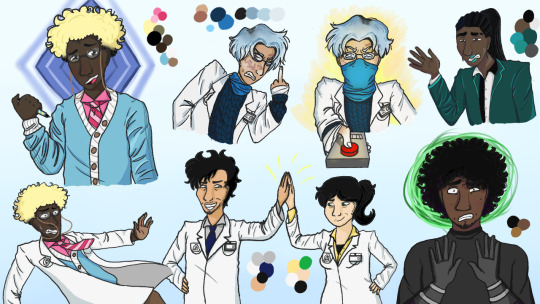



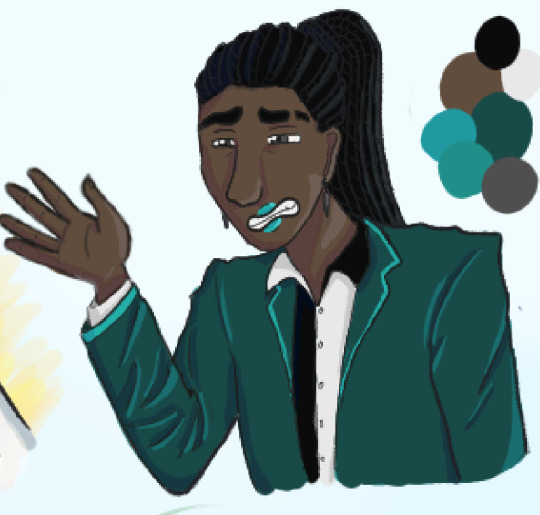

MISCELLANEOUS SCP STAFF DESIGNS BE UPON YE
(image ids in descriptions)
#dr glass#dr simon glass#simon glass#dr iceberg#julian iceberg#agent diogenes#draven kondraki#agent kondraki#dr scranton#dr robert scranton#dr lang#dr anna lang#scp 3001#scp#scp foundation#scp fandom#scp fanart#scp art#scp doctors#scp staff#scp mtf#character design#character art#artists on tumblr#digital art#digital drawing#illustration#digital illustration#art dump#my art
75 notes
·
View notes
Text
Me with the sillies <333



They're the sillies and I love them sooo much!!
#until dawn#emily davis#matt taylor#resident evil village#mia winters#ethan winters#scp foundation#scp 3001#Anna Lang#dr. robert scranton#Dr. Anna Lang
12 notes
·
View notes
Text



some...
58 notes
·
View notes
Text
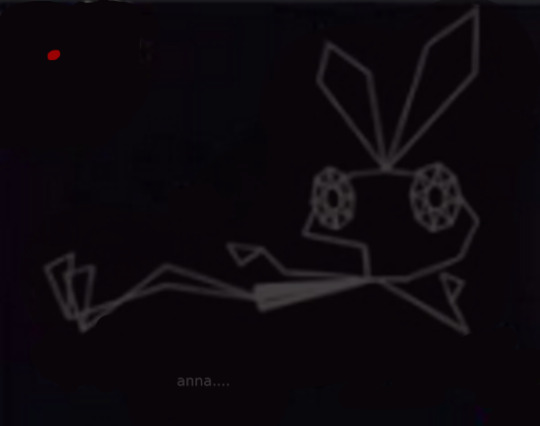
@mysticalclouds8 gave me the idea so. here we are
6 notes
·
View notes
Text
New niche obscure crossover au upon ye!
This time on Ingo getting eeby deebied: SCP 3001!



Some of my followers might have heard of 3001 bc I love this article, but here's some context:
Short version: a scientist accidentally opens a wormhole into a dimension where nothing exists, and he starts to fall apart because the nothingness is contagious.
Long version: Robert Scranton researches ontokinetics, the physics of reality warping and how to counter it. He and his wife, Anna Lang are working on something they call the Lang-Scranton Stabilizer that they believe can stop things that would warp or manipulate reality in dangerous ways.
An earthquake happens on site and breaks many prototypes, causing a wormhole to open up and suck Robert in, along with a nearby control panel. For the next five years, Robert records his experience and his slow descent into madness on that control panel. The control panel returns to reality, telling the people in the real world what happened for the five years it was recording, but Scranton's true fate is unknown. It seems unlikely he makes it out alive.
The original article is heartbreaking and has some descriptions of gore and psychological horror, but if you are good with that, I encourage you to check it out! My au will be lighter on the psychological horror but about the same on gore, so.
Of course, I had to get attached to this sad man and his sad ending. So I will be throwing Ingo into the evil nothingness dimension so I can pull him out and give him the happy ending I want for Scranton sjjsjfnncn
This is a dojoshipping au bc it's my favorite ship and I feel like Robert and Anna are precious to me. Really that's the only reason why. *Holds Zisu gently* I just think she's neat.
Extra doodles, as a treat!

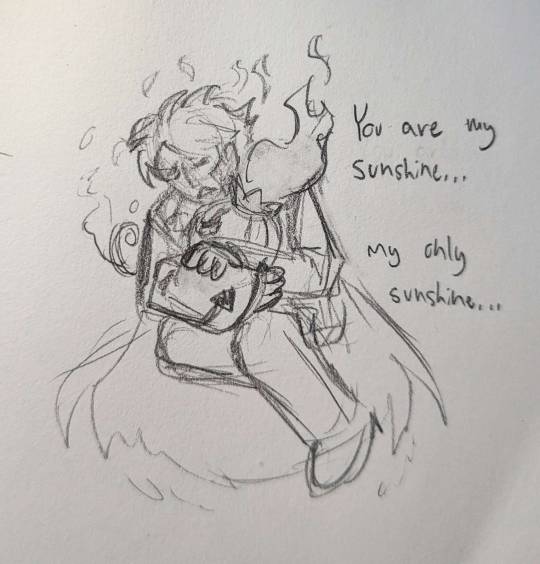
137 notes
·
View notes
Text
Despite years of knowing it exists, I am still a SCP Foundation newbie who primarily obtains SCP knowledge through animated story-telling YouTube channels. So bear with me I guess. But I want to actually make a post in-tag talking about the woman from this SCP-978 log of SCP-106 here:

Almost every post I've seen that talked about it claimed the old woman to be SCP-106's wife. I think that's a reasonable prediction, only IF it ignores all of the popular theories of SCP-106's origins linked in his page. Of course, the beauty of SCP lore is that as a fan you get to decide what canon to believe and not to believe yourself. That also means that this log should have no effects on how people view SCP-106, but I want to discuss what I believe who this woman that the editor who added this log(http://www.wikidot.com/user:info/metheguy12) intended to be, since uh, I'm getting the idea that people are largely believing the woman to be SCP-106's spouse DUE to "Until Death" and "The Young Man" suggesting SCP-106 to be once human... despite how this seems unlikely when you consider the context of both stories.
So, firstly- "Until Death", the only story where SCP-106 as Robert Scranton is clearly stated to have a wife, Anna Lang wouldn't fit this narrative because if the woman was her, the Foundation would be able to identify at least how the woman "appears to be her". From that we can simply cross out the possibility of this log being about Robert Scranton-106 completely. If the SCP-106 MeTheGuy12 had in mind when adding this log followed the tale of "Until Death", there is NO FUCKING WAY that woman wasn't Anna. Or maybe it was. Maybe it was and the Foundation just decided not to name, not even mention the possibility of that woman being her. Maybe that's it. That's the whole mystery solved and by posting this on tumblr dot com MeTheGuy12 would find this post and prove me wrong and stupid, but that's so unlikely to happen haha have you even considered the real-godzekiel lore, the MeTheGuy12 lore and the tumblr dot com lore?????????? 😹😁💀
As for "The Young Man", if Corporal Lawrence had a wife, she would be 20-40 years old during the war because despite a few exceptions, there is a maximum age range. This means if the woman was his wife, it'd be her about 20 to 40 years after his "Incident", about year 1940 to 1960. Why's that, that century egg Lawrence would desire, specifically, to be with the 20-to-40-years-after-WW1-and-last-seeing-her and likely 40-to-70-years-before-the-time-this-log-was-written version of his wife? That doesn't make sense. (Or maybe. Okay. Okay maybe he and she just had a 20-40 age gap but that's fucking weird and I don't like it. ) Here's a list of who the woman could be that does make sense to me:
That woman's not a person that SCP-106 ever knew, but by desiring to be welcomed by her, it shows how despite his sadistic bloodlust and anomalous properties, he still desire the basic human need for acceptance and normalcy. If that's the case, the fact that the woman is old would be really interesting. Either that she must be as far off from the 10-25 age bracket as possible to not trigger violent tendencies or that the Old Man really just wanted an Old Woman to be with. I have no clue what I'm talking about.
That woman's meant to represent SCP-106 memory of a maternal figure or older relative. It's his mom, let's say. If he was 20-40 when he went to war, her mother being in her 60s definitely makes sense. If the woman was his mother, it'll also suggest that the place that he most desires to be in is the farm he grew up in. That's pretty sad I think, if you can't find untainted happiness in anywhere but childhood. I think.
Ok, last thing to point out: SCP-106's appearance does not change in his photo. The text does not point out any differences that SCP-106 has in the photo compared to him in reality, despite probably his corrosive touch if nothing in this log suggests the wheat field to be affected by it. Something something wanting to be understood for who he is and not just someone that he once was something something.
Jesus Christ what was I on.
#might add to this later#scp#scp foundation#scp fandom#scp community#scp 106#scp-106#scp 978#scp-978#long post
33 notes
·
View notes
Photo
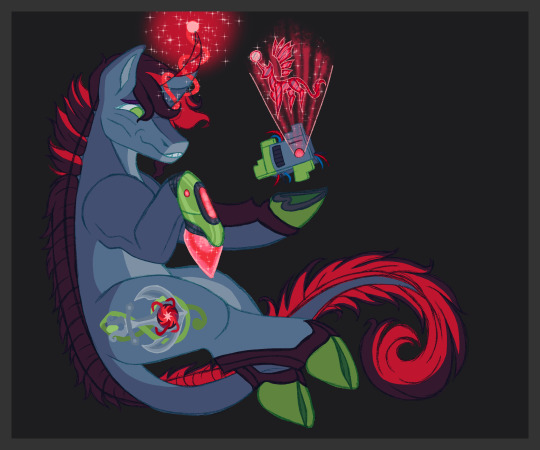


By popular vote here is Dr. Scranton, his sanity recorder Red, and SCP 3001 in general.
I like the design a lot but don't really know how to do all the glowing and holograms bits. But this get it across
Headcanons are in the Keep Reading section
I’m segmenting this into two sections one for Scranton himself and another for Red. As for the 3001 reality itself I may make another post about it specifically but I think it is quite self evident what goes on there.
Dr. Robert Scranton
Unicorn, as I can’t help it. I wanting him to be able to make a small ball of light at the tip of his horn. Like how many drawings of SCP 3001 use a red dot to indicate the whole event.
His horn is multi tones with his fur color and some reds.
Because of mlps weird destiny/fate trait, most of his design is around red popping out of a darkness refers back to SCP 3001
His cutie mark however is for the creation of reality anchors.
First character to have horse shoes on this side blog
While in SCP 3001 he became really emaciated. In the drawing he’s not because I want a nicer reference drawing if I draw him again.
He got near just skin and bones near the end.
Didn’t send off his ring with his severed hoof as it is on his horn. Drawing doesn't have this though.
He did finally figure out how to get back. So he’s back working on anchors at the main Site.
Still doesn’t have a hand, or like last two joints of his leg, so he got a prosthetic arm to help. Also has a recorder, Kant counter, and anchor in the prosthetic.
It uses magic to make the hoof. Hold up weight up pretty good.
He got back via reality bender. Learning how to in the conditions was both helpful, with so low hume levels, and detrimental, he was floating in nothingness going mad.
Even though his is technically a reality bender he has no idea how to do any of it outside of adding it to a teleport spell and that normal level of humes fuck up even the few things he knows how to do.
Clef begrudgingly has to teach Scranton how to not unintentionally reality bend.
Scranton is really into the teaching so he can have the prospective of how reality benders function and how they can hide their abilities or even reverse them.
Also would need to go through the occasional evaluation, so more Clef interactions
Just know he still loves his wife
Tail didn't use to be this long it got warped from SCP 3001
Red (Recording Device Panel)
So Scranton may have personified his companion a lot
Wilson ball-ed it
After a while Scranton started to uses his magic to manifest a pony in the light given off to make himself feel a little bit less lonely.
Got made to be an alicorn as a way to fell more at ease and to the fact that it was the only object with light and was the only thing that didn't warp out of existence yet so lording over the reality itself
Also thing might have become slightly sentient.
Sentient not sapient.
No one has an idea if it can keep things in memory, understands languages, or even has opinions on stuff.
Red just like looking at objects and people and seems to sense noise and when send noise comes from a pony.
He does seem to understand that “Red” refers to themselves.
Some research think this, while the rest just think Scranton’s magic also got recorder as he started to reality bend. Which is half true.
Dr. Anna Lang kept the recorder as it wasn't a bloody severed hoof sent back by her husband. That hoof is probably a wet specimen somewhere, I’ll be honest.
She had noticed the weird anomalous effect in the recorder before Scranton came back fully. But didn't know what to do with it.
Now back Scranton keeps Red on his person as a comfort item.
He will talk to it in the middle of the day. Everyone just looks at him with confused to why, but ultimately thinks nothing of it as everyone else in the Foundation is just as weird. This might be on the tame end of weird quirks.
#scp#mlp#SCP Pony AU#Dr Scranton#SCP 3001#headcanons#unicorn#alicorn#hologram#cutie mark#scp doctors#cw severed limb mentions#cw starving mentions
16 notes
·
View notes
Note
Here's my not!propaganda for SCP-106, The Old Man:

SCP-106, informally known as "The Old Man", is one of the most vicious, sadistic, brutal, and dangerous anomalies locked up by the Foundation. He's an elderly humanoid entity with a general appearance of very advanced decomposition. His appearance varies between witnesses, but the "rotting” quality is observed in all of his forms. When attacking, SCP-106 will attempt to incapacitate prey by damaging major organs, muscle groups, or tendons, then pull disabled prey into its pocket dimension. SCP-106 appears to prefer human prey items in the 10-25 years of age bracket. This is especially concerning because of something Dr. Gears mentions in "The Leak":
"What is 106 doing to the people he takes?
It's bad. Remember that 106 is basically god inside that place it slides in to. The physical damage is almost secondary to the things it does to the mind of people. It seems to have a personality similar to a very elderly serial killer, or child molester. It can't do all that it did back in the day…but age, wisdom, and well-developed cruelty have taken the place of thrills and sexual gratification. Recordings exist, both audio and video, which C.R. will never release. They'd never get anybody to work around the damn thing ever again."
SCP-106 causes a “corrosion” effect in all solid matter it touches, engaging a physical breakdown in materials several seconds after contact. This is observed as rusting, rotting, and cracking of materials, and the creation of a black, mucus-like substance similar to the material coating SCP-106. This effect is particularly detrimental to living tissues, and is assumed to be a “pre-digestion” action. Corrosion continues for six hours after contact, after which the effect appears to “burn out”.
There are two version of 106's backstory that support him being a Corruption Avatar. The first is "Until Death," where he's what remains in Robert Scranton after escaping the Red Reality. Warped beyond recognition, he kills people to steal their organs for his failing body and seeks out his wife Anna, only to kill her with his deadly touch.
"It was a mountain of decomposing limbs and organs, limp and slick. They slithered down at her under the weight of the pile, trailing gore. She retched at the deep, foul smell of putrescence, flailing wildly to pull herself free. A bloated hand pawed at her leg as it fell, and she felt something slippery and soft under her feet as she stood."
"The old man reached towards her, tenderly holding her cheek. Her skin puckered and liquefied, flesh dripping from her face. It brought its grinning mouth to hers and kissed her, and her teeth became hot wax, fusing and corroding.
She screamed then. The old man pressed his kiss harder into her open mouth, his swollen grey tongue melting hers and filling her throat with molten muscle and caustic jelly. The last thing she felt was the weight of the two of them, sinking into the floor, locked in a final, burning embrace."
The other 106 backstory--the one that supports him being a Corruption Avatar even more--is "The Young Man."
"Nobody could like Corporal Lawrence [...] However, in the trenches of World War I, normalcy was at best a relative term, and one that had minimal relation of life, such as it was [...] So what if people felt increasingly uncomfortable around him? In a place where the flesh rotting off your bones while you were still alive was the base-line of concern, a little personality conflict ranked several levels below a paper cut."
In this story, Lawrence was Corporal Lawrence, a soldier in WWI. While war is usually the purview of The Slaughter, the opening lines discussing chemical weapons align the horror of this particular war story with The Corruption. As for Lawrence, he was disliked by his comrades because of his odd mannerisms. Most of these seem like harmless quirks, but one is worth noting:
"He rarely slept as well, and bunkmates said he would mumble in his sleep almost constantly. The content of those nocturnal ramblings, when they could be understood, were often odd, and potentially unsettling. One private moved to another barracks when he heard the name of his daughter pass Corporal Lawrence's lips, followed by a bubbling, muffled giggle."
Another thing that aligned Lawrence with the Corruption was the aura of malaise that seemed to surround him:
"Whispers filtered among the grunts of the corporal being a curse. Nearly every man who'd shared a bunkhouse with him had gotten trenchfoot, and the rooms he haunted always seemed to smell more musty and sickly-sweet, even for the trench."
Still, Lawrence could have easily been nothing more than an odd man whose paperwork was lost in the chaos of war. But he definitely wasn't normal after he was sent to investigate the "nightmare trench."
"The men, already nervous, were not calmed by their investigation. The trenches stank of mold, sweat, and a thin undertaste of rotten fruit. A vile, cloying slime seemed to have pooled in every divot and crack, sticky as glue and itchy on the flesh. In a world where rats and insects would try to snatch food from your mouth even as you ate, they saw nothing alive, not so much as a fly [...]
Private Dixon found the first body, and managed to cry out before vomiting.
They knew it had been a man only because nothing else of that size could have been there. It lay on the floor of a barracks. The entire floor. The flesh of it had been…smeared, somehow, spread like butter over the rough dirt floor. Bones, already looking pitted and rotten, stuck out at random angles, like dead trees in a still swamp. The skull rested on one of the highest bunks, facing the doorway, ten gleaming white fingertip bones crammed into the cracked eye sockets. As one man went to examine it, he found the back of the skull had been crushed open, the rotting, sagging sponge of a tongue stuffed into the otherwise dry cavity.
More remains were found, each seemingly more unsettling and strange than the last. A ring of hands in a sandbagged watchpost, ten of them, fingers interlaced like a basket, the wrists ragged and broken. Two men in a tunnel, skin leathery and thin as mummies, eye sockets staring and empty, mouths locked impossibly wide, their clothes mere rags under an oily black scum. The latrine sent even the hardiest back, gagging and shivering. Overflowing with excrement and offal, gobbets of meat bobbed and oozed in the foul sludge… the whole surface dotted with what looked like thousands of clean, slick eyeballs, nerves and tendons fanning out like goldfish tails."
Corporal Lawrence found the apparent source of the nauseating scene: a pit of a black, mucus-like substance, which he then fell into. When he came out, the other men took him back to the trench, but he seemed to be alright. Better than ever, in fact--he was in unusually high spirits and much, much more talkative: "He rambled about the joys of close spaces, of creation and destruction that seemed to spring up all around them." This behavior freaked out poor Private Dixon, who "whispered to a friend that he had woken once to find the corporal standing over him in the night, his eyes as bright and flat as silver dollars. They found the private the next day snarled in the barbed wire, his intestines spread nearly ten feet around him in every direction." Soon afterward, disaster struck the trench:
"Not one man from that trench survived the Great War, although few died in battle. A wave of sickness took the trench a few days after Private Dixon's death. A strange wasting sickness, it seemed to eat the flesh like acid, men waking to find previously healthy flesh eaten down to the bone, oozing and blackened. A sergeant was found in a latrine, beset by a living carpet of rats. They refused to quit the body even when shot, and attacked several men before the body was recovered. Relief finally came, the bulk of the men being sent to various hospitals, many wasting away before they ever reached a bed."
As for Lawrence, he was remanded to a mental ward after sexually assaulting and maiming a nurse. At the ward, he frightened everyone else because "A stale, musty foulness seemed to sit in the air wherever he stayed, and incidents of infection and the strange, consuming sickness that had beset his home trench seemed to follow him like a cloud."
If Lawrence hadn't already been turned into a Corruption Avatar by falling into that pit, he definitely was one by the time he vanished from the ward:
"Corporal Lawrence and eighteen men vanished one November night [...] The room reeked of rust, oil, mold, and sweet rot. Thick, black swaths of crumbling ooze coated the beds and several of the walls, wide patches of it smearing and eating into the floor. Of the men, there was no sign, at first. As they searched, one nurse shifted a bed aside, only to shriek and nearly trip across one of the sunken, reeking depressions on the floor. In a tight, perfect spiral were what appeared to be hundreds of teeth, resting neatly on the floor. After counting, they accounted for the total of all the teeth of every living soul in that ward…but one."
In conclusion, "The Young Man" is basically a Corruption Statement about the disgusting horror of WWI, where chemical weapons and sickness lurked around every corner. Lawrence was a "toxic" man hinted at already having predatory desires who brought sickness and stench wherever he went. However, coming into (possibly fatal) contact with a particularly strong manifestation of The Corruption--one that had already claimed an entire trench--warped him into a disgusting monster of rot and plague who brought sickening death wherever he went, until he finally abandoned his humanity entirely to become The Old Man.
TLDR; SCP-106 is so, so disgusting both because of the decaying slime and his implied sexual predator personality, and two of his backstories further this. "Until Death" portrays him as a more tragic kind of Avatar, who wants nothing more than to reunite with his beloved wife but is so far gone that their reunion causes him to kill her, whether by accident because of his mental degradation or as a twisted way of having her forever. "The Young Man" suggests that he was an ordinary person whose disgusting personality caused him to embrace The Corruption.
.
17 notes
·
View notes
Text
every day of my fucking life i think about dr scranton and anna
3 notes
·
View notes
Note
*waddles into your ask box and rustles through a bag filled with small character figurines before pulling one out* this is robert scranton. my blorbo. he is a guy and he is the main character in scp 3001, the red reality, which heavily contributed to what the foundation knows about hume theory today. he has a wife, anna. and he likes to sing to her. in my hc, theyve been married for almost 40 years-
knowing what i know about robert scranton and having read the article before... good on you, anon, you're right, he sings to his wife and they've been married for 40 years! they're so happy together!

4 notes
·
View notes
Text

“ITALIAN FAMILY LOOKING FOR LOST BAGGAGE.” ELLIS ISLAND 1908 LEWIS W. HINE
Anna Gustozzo [née Sciacchitano] b. 1872; Paolo Gustozzo (b. 1897); Maria Gustozzo (b. 1905); Domenico Gustozzo (b. 1907). All came from Santa Margherita di Belice, Sicily and were traveling to Scranton, Pennsylvania.” Source: The New York Public Library Digital Collections
14 notes
·
View notes
Photo

Angels mark the grave of Mr John Scranton and his wife Anna.
West Cemetery
Madison CT 8/30/22
8 notes
·
View notes
Text
Random iideas for fics
Some suggestive ideas as well so be warned
Au where Anna Lang gets "looped"/revived whenever she gets killed, so like, in until death, she dies and then gets looped back to a day before the whole incident and she has to convince Robert to not go to work tomorrow but she can't say why or he might think she's crazy or something.
"Aunt Rhody"/"Lonely Rhody" AU, where Anna ALSO gets turned into a SCP 106-like anomaly after "until death"(nobody knows HOW but she calms down Robert so no one's complaining). She's a lot more docile and calm but shares the same abilities as SCP-106 so the staff just put them in the containment chamber together and let them cuddle, she doesn't need food and water but she requests it and she also sleeps a lot too, seemingly always tired. SCP-106 is extremely clingy towards her and attempting to put them in separate chambers has resulted in at least 2 breaches.
Anna being the only one who can touch SCP-106 without burning and melting away and dying(this one because I'm going insane and maybe becoming delusional <333)
"Private recording" okay, so, I can imagine Anna listened to all of the recordings from the LSS panel whether that was at the lab or at home somehow and probably cried a lot and grieved but, basically, at some point, there's a recording where Rob is just like, masterbating, thinking of his wife and all that but she's actually hearing it this time and she's just, shocked which, yeah. Body horror and horror eroticism ig?
#dr. robert scranton#dr. anna lang#scp 3001#scp 106#fic ideas#The masterbating one was inspired by a fanfic I found here#It was of John doe#I miss that guy#He was the first dude to introduce me to yanderes and self-aware characters#So he holds a special place in my heart
2 notes
·
View notes
Text

107 notes
·
View notes
Text
Philosopher Lisa Doeland wonders in 'Apocalypsofie': extinction, how do you introduce that well?

New Yorkers flee a tsunami in Roland Emmerich's film The Day After Tomorrow, 2004
In an intensely polluted world that will never get clean again, we must try to get it right. How? Philosopher Lisa Doeland comes up with an honest, searching answer in her book “Apocalypsofie”.
When I'm about ten pages into her new book “Apocalypsofie” [1], I wonder whether Lisa Doeland would have children. Whoever describes the climate crisis bluntly as an apocalypse does not have a rosy picture of the future. Why would you then even start having children?
For Doeland, an apocalyptic is not the same as a doomsayer, it soon becomes clear. The Dutch philosopher may not be an ecomodernist who puts all her hope in technological innovation, but she is not a prophet of doom either. She just wants to avoid the polarisation between doomsayers and ecomodernists with her "apocalypsophy" (that term is her invention). After all, both pessimism and optimism give us an illusion of distance: the future will be bad or good. But, Doeland subtly observes, it's not about the future, the downfall has already started. Her apocalypsophy is a manual for how we can still live in the full awareness of that harsh truth.
What is possible
“After a century and a half of industrial production, mass consumption and thoughtless discarding, the remains of this process are piling up visibly and invisibly, and instead of trying to hide them away and start with a clean slate, it is up to us to learn to live in and with the debris. How do you do that?”
Doeland hesitantly answers that crucial question in her book. It is only at the last chapter that readers get a little insight into what they have to do. Much more attention is paid in Apocalypsophie to the analysis of the problem and of wrong solutions. Where do the ruins come from? Why was the Club of Rome[2] never listened to? What fantasies lull us further into ruin? The philosopher looks for an answer dialoguing with big names of fellow philosophers such as Jacques Lacan[3], Bruno Latour[4], Jacques Derrida[5], Walter Benjamin[6], or living epigones in the current eco-movement such as Donna Haraway[7] or Andreas Malm[8].
But also lesser-known (and therefore all the more interesting) philosophy is accessible in Doeland's story, such as the work of Srećko Horvat[9] (After the apocalypse), Roy Scranton[10] (Learning to die in the anthropocene), Michael Marder[11] (Dump philosophy), Anna Tsing[12] (The mushroom at the end of the world), Val Plumwood[13] (The eye of the crocodile).
Doeland takes up the warnings of Derrida, Benjamin and Horvat: we are already living in the catastrophe, the world is already a dump, don't be fooled. She takes constructive advice from Tsing, Haraway and Plumwood (coincidentally, the female thinkers?): don't fear the future, but look around and learn to see what's possible.
Completely in line with the etymological meaning of 'apocalypse', Doeland sees the ecological crisis as a revelation: not of a grand vision about the end of 'the' world, but the revelation of the insight that many worlds have long since ended. The main appeal of this book is: don't think it's five to twelve or that we can still be saved, but look around you and see that the mass extinction (of insects and other animal species, of indigenous cultures, of pre-industrial societies ...) is taking place worldwide.
What can we do with that insight? According to Doeland, it protects us against what she calls dangerous fantasies: the energy transition, for example, or the circular economy that hides the real problem from our view with the promise of waste as a raw material. That real problem, says Doeland, is the capitalist need for eternal growth. And the circular economy only makes it bigger: 'The belief in the recyclability of things means that we no longer view waste as a problem, as the dark side of our disposable consumer society, but as part of a more or less natural cycle, so we don't have to worry too much about it.'
Undead waste
Destination is strict. Electric cars and solar panels are not a solution, they are part of the problem. Concepts such as 'energy transition' and 'green energy' continue to hide polluting processes of extraction and combustion. Batteries, plastic and car tires not only have to be produced, but also discarded after decay. This is how the machine of capitalism produces piles of waste that cannot be digested: undead waste, as Doeland calls it, huge piles of e-waste and plastic that haunt us and future generations.
Surprisingly, Doeland is equally sceptical about rewilding projects and veganism, if they are based on a false ideal of untouched nature or moral purity. After all, nature not only includes trees and oceans, but also nuclear waste under the soil and plastic in the sea. The fantasy of nature as a pristine canvas against which man can develop cultures is at the root of the capitalist exploitation of the earth.
Even so, the desire for a clear moral line between what is edible (plants) and what is not (animals) rests on a bad fantasy. All food is sacred, says Doeland together with ecofeminist Plumwood. And that all consumption of food is consumption of suffering is a thought she borrows from anarchist Alexis Shotwell[14]. Because everything on earth is so intensely intertwined with everything, people can no longer shut themselves off from all that is bad: plastic is in breast milk, lead in our blood, soy milk is produced industrially. Moral purity is an illusion.
Cloudy ethics
In an intensely polluted world that can never be made clean again, we must try to get it right. And we can do that well or less well. Unfortunately, even for Doeland, it is not always clear what that means in practice. She herself gives the example of diapers (so yes, she has children!). She opted for washable instead of disposable diapers, but is not sure whether that was the best choice. Was it worth all the energy?
“You must realise that you can never do everything right.” The answer to the question “How to live amidst the ruins?” is unsatisfying, but fair. For me, the most difficult challenge is not to keep myself ongoing confronted with the realisation of millions of climate refugees or the destroyed ecosystems and biodiversity, but rather: 'how do I raise children in this world?'
British Charlie Gardner[15], one of the founders of Scientist Rebellion[16], left the academy because he could no longer bring science to auditoriums full of young people, condemning them powerlessly to a bleak future. Lying to the next generation is not an option, so what do we tell them? The book Apocalypsophie is full of beautiful metaphors and intriguing provocations, but how do I translate them into a life with children? Shall I teach them 'how to get extincted properly', as Doeland sharply puts it? Is there still room for humour and happiness, for joie de vivre and fun? I suspect that Lisa Doeland assumes so, because she has chosen parenthood just like I did. But frankly talking? I'm not very sure.
Source
Katrien Schaubroeck, Filosofe Lisa Doeland vraagt zich in ‘Apocalypsofie’ af: uitsterven, hoe doe je dat goed?, in: De Strandaard, 5-08-2023, https://www.standaard.be/cnt/dmf20230803_94888668
[1] Lisa Doeland: Apocalypsofie. Over recycling, groene groei en andere gevaarlijke fantasieën. (Apocalypsophy. About recycling, green growth and other dangerous fantasies) , Ten Have, 2023 https://www.uitgeverijtenhave.nl/boek/apocalypsofie/
[2] The Club of Rome is a nonprofit, informal organization of intellectuals and business leaders whose goal is a critical discussion of pressing global issues. The Club of Rome was founded in 1968 at the Accademia dei Lincei in Rome, Italy. It consists of one hundred full members selected from current and former heads of state and government, UN administrators, high-level politicians and government officials, diplomats, scientists, economists, and business leaders from around the globe. It stimulated considerable public attention in 1972 with the first report to the Club of Rome, The Limits to Growth. Since 1 July 2008, the organisation has been based in Winterthur, Switzerland.
[3] Jacques Marie Émile Lacan (13 April 1901 – 9 September 1981) was a French psychoanalyst and psychiatrist. Described as "the most controversial psycho-analyst since Freud", Lacan gave yearly seminars in Paris, from 1953 to 1981, and published papers that were later collected in the book Écrits. His work made a significant impact on continental philosophy and cultural theory in areas such as post-structuralism, critical theory, feminist theory and film theory, as well as on the practice of psychoanalysis itself.
[4] Bruno Latour (22 June 1947 – 9 October 2022) was a French philosopher, anthropologist and sociologist.He was especially known for his work in the field of science and technology studies (STS).After teaching at the École des Mines de Paris (Centre de Sociologie de l'Innovation) from 1982 to 2006, he became professor at Sciences Po Paris (2006–2017), where he was the scientific director of the Sciences Po Medialab. He retired from several university activities in 2017.He was also a Centennial Professor at the London School of Economics.
[5] Jacques Derrida (15 July 1930 – 9 October 2004) was an Algerian-born French philosopher. He developed the philosophy of deconstruction, which he utilized in numerous texts, and which was developed through close readings of the linguistics of Ferdinand de Saussure and Husserlian and Heideggerian phenomenology. He is one of the major figures associated with post-structuralism and postmodern philosophy although he distanced himself from post-structuralism and disowned the word "postmodernity"
[6] Walter Bendix Schönflies Benjamin (15 July 1892 – 26 September 1940) was a German Jewish philosopher, cultural critic, and essayist. An eclectic thinker who combined elements of German idealism, Romanticism, Western Marxism, Jewish mysticism, and Neo-Kantianism, Benjamin made enduring and influential contributions to aesthetic theory, literary criticism, and historical materialism. He was associated with the Frankfurt School, and also maintained formative friendships with thinkers such as playwright Bertolt Brecht and Kabbalah scholar Gershom Scholem. He was also related to German political theorist and philosopher Hannah Arendt through her first marriage to Benjamin's cousin Günther Anders.
[7] Donna J. Haraway is an American Professor Emerita in the History of Consciousness Department and Feminist Studies Department at the University of California, Santa Cruz, and a prominent scholar in the field of science and technology studies. She has also contributed to the intersection of information technology and feminist theory, and is a leading scholar in contemporary ecofeminism. Her work criticizes anthropocentrism, emphasizes the self-organizing powers of nonhuman processes, and explores dissonant relations between those processes and cultural practices, rethinking sources of ethics
[8] Andreas Malm (born 1976 or 1977) is a Swedish author and an associate professor of human ecology at Lund University. He is on the editorial board of the academic journal Historical Materialism, and has been described as a Marxist. Naomi Klein, who quoted Malm in her book This Changes Everything, describes him as "one of the most original thinkers on the subject" of climate change.
[9] Srećko Horvat (born 28 February 1983) is a Croatian philosopher, author and political activist. The German weekly Der Freitag called him "one of the most exciting voices of his generation" and he has been described as a "fiery voice of dissent in the Post-Yugoslav landscape". His writing has appeared in The Guardian, Al Jazeera, Der Spiegel, Jacobin, Newsweek and The New York Times.
[10] Roy Scranton (born 1976) is an American writer of fiction, non-fiction, and poetry. His essays, journalism, short fiction, and reviews have appeared in The New York Times, Rolling Stone, The Nation, Dissent, LIT, Los Angeles Review of Books, and Boston Review. His first book, Learning to Die in the Anthropocene was published by City Lights. His novel War Porn was released by Soho Press in August 2016. It was called "One of the best and most disturbing war novels in years" by Sam Sacks in The Wall Street Journal. He co-edited Fire and Forget: Short Stories from the Long War. He currently teaches at the University of Notre Dame, where he is the director of the Environmental Humanities Initiative
[11] Michael Marder is Ikerbasque Research Professor of Philosophy at the University of the Basque Country, Vitoria-Gasteiz. He works in the phenomenological tradition of Continental philosophy, environmental thought, and political philosophy.
[12] Anna Lowenhaupt Tsing (born 1952) is an American anthropologist. She is a professor in the Anthropology Department at the University of California, Santa Cruz. In 2018, she was awarded the Huxley Memorial Medal of the Royal Anthropological Institute.
[13] Val Plumwood (11 August 1939 – 29 February 2008) was an Australian philosopher and ecofeminist known for her work on anthropocentrism. From the 1970s she played a central role in the development of radical ecosophy. Working mostly as an independent scholar, she held positions at the University of Tasmania, North Carolina State University, the University of Montana, and the University of Sydney, and at the time of her death was Australian Research Council Fellow at the Australian National University.[5] She is included in Routledge's Fifty Key Thinkers on the Environment (2001).
[14] Alexis Shotwell (b. 1974) is a Canadian philosopher, currently employed as Professor in the Department of Sociology and Anthropology at Carleton University in Ottawa, where she is cross-appointed with the Pauline Jewett Institute of Women's and Gender Studies and the Department of Philosophy. Educated at University of California, Santa Cruz (PhD), Dalhousie University (MA) and McGill University (BA), Shotwell has also taught at Laurentian University.
[15] Dr. Charlie Gardner’s professional identity cannot be summed up by a simple job title: he is, simultaneously, a lecturer and researcher in conservation science at the University of Kent, a practitioner and an activist with Extinction Rebellion. To him, these are not separate roles. They strengthen each other in his determination to align science with activism in order to save our planet. We spoke with Charlie about his unique approach to science and the multiple ways in which he uses his work life to make a real-world impact for all our sakes.
[16] Scientist Rebellion is an international scientists' environmentalist group that campaigns for degrowth, climate justice and more effective climate change mitigation. It is a sister organisation to Extinction Rebellion. It is a network of academics that tries to raise awareness by engaging in non-violent civil disobedience.
0 notes
Text

Gaster: Sans, you can turn into a skeleton at will. What is the point of this costume?
Sans: c’mon, pops. you’re snow fun.
Anna: Just let him pretend to be a kid who’s pretending to be a skeleton.
Gaster: He’s already both of those things???
Happy halloween! A little late, but I had a busy day. I know this specific costume idea for the skelefam is really overdone, but I actually don’t care. Nightmare before Christmas was my childhood, and I just recently saw it again for the first time in years. Also, I will take any excuse to draw Anna being cute.
I hope y’all enjoyed free candy day!
My sketch comms are open.
#halloween#undertale#gaster#sans#papyrus#anna scranton#happy spooky day#wife reveal?#i guess you wouldn’t know anna unless you read scp-3001#heres where we get really au#reasons why sans prefers being a skeleton to being human:#he don’t have to brush his hair#crap i forgot the rings#pretend they’re there please
27 notes
·
View notes